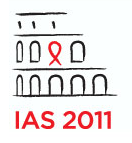SPARTAC trial: treatment in primary infection for 48 weeks shows small delay in disease progression
1 August 2011. Related: Conference reports, Antiretrovirals.
 Polly Clayden, HIV i-Base
Polly Clayden, HIV i-Base
The main objective in the SPARTAC trial was to look at the impact on disease progression from two different short courses of antiretroviral treatment (ART) initiated during primary HIV infection compared to no immediate ART. Sarah Fidler from Imperial College London presented results from SPARTAC in an oral late breaker at IAS 2011.
In this study, adults with primary infection who were within 6 months of seroconversion were randomised to receive ART for 48 weeks, 12 weeks, or no therapy (standard of care, SOC). The primary endpoint was time from randomisation to either CD4 <350 cells/mm3 or initiation of continuous ART.
A sample size of 360 was calculated (using data from CASCADE) to provide 90% power to detect relative reduction in risk of time to primary endpoint of 50% – 25% in each of the ART arms compared to SOC over four years of follow up.
A total of 366 participants were randomised from 35 sites in Australia, Brazil, Europe and Africa; 40% were from the UK and 35% South Africa. Of these, 60% were men (90% MSM) and 40% African women, with a median age overall of 31 years.
As would be expected, the median baseline CD4 was high at 543 cells/mm3 and viral load was 4.7 logs (~50,000 copies/mL). Participants were followed for a median of 4.2 years and 19% were lost to follow up. The majority (92%) of participants received lopinavir/r plus AZT and 3TC.
The investigators found no difference in time to primary endpoint in participants receiving 12 weeks of ART compared to SOC (HR 0.93: 95%CI 0.67-1.29, p=0.67). However, 48 weeks of ART conferred a statistically significant delay (HR 0.63: 95%CI 0.45-0.90, p=0.01). The median time to primary endpoint was 157, 184 and 222 weeks for the SOC, 12 week and 48 week arms respectively. Although, Dr Fidler noted that the 65 week (95%CI 17-114) delay in the 48-week arm was not significantly greater than the time spent on treatment.
A post hoc analysis revealed two findings. There was a significantly more rapid rate of disease progression among participants identified within 12 weeks of acquiring infection in the SOC arm. Secondly, the delay to primary endpoint observed previously with 48 weeks of treatment compared to SOC was greater in participants who initiated ART initiated within 12 weeks of infection (HR 0.48: 95%CI 0.3-0.78). Overall, the investigators reported a non-significant trend to greater delay to primary endpoint the closer ART was initiated to the estimated time of seroconversion (p=0.09, NS).
There was a reduction in viral load of approximately half a log after interrupting ART in the 48-week arm compared to SOC, which was sustained until 60 weeks after stopping treatment. The mean CD4 count over the entire study period was 138 cells/mm3 higher in the 48-week arm than standard of care.
There were no significant differences between arms in AIDS, death or serious adverse events. In contrast to SMART there was no rebound in IL-6 and a drop in d-Dimer, compared to baseline, four weeks after stopping ART.
comment
By the time this study was completed the treatment landscape had changed considerably from when it was initially designed. So the big question now is what would have happened with a continuous treatment arm?
As far as the implication for clinical practice is concerned, perhaps if someone is aware of their status and he or she wants to start treatment in primary infection there may be a slender argument to do so. But if they do start and are doing well, given the modest time off treatment until starting again, why stop?
Reference
Fidler S et al. The effect of short-course antiretroviral therapy in primary HIV infection: final results from an international randomised controlled trial; SPARTAC. 6th IAS Conference on HIV pathogenesis, treatment and prevention. 17-20 July 2011. Rome, Italy. Oral abstract WELBX06.
http://pag.ias2011.org/Abstracts.aspx?SID=90&AID=4711

